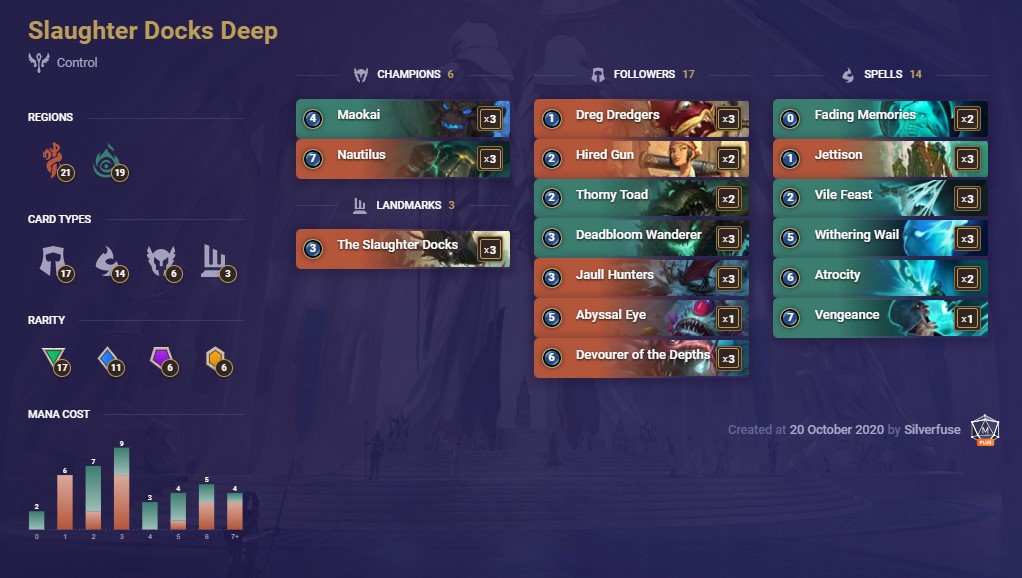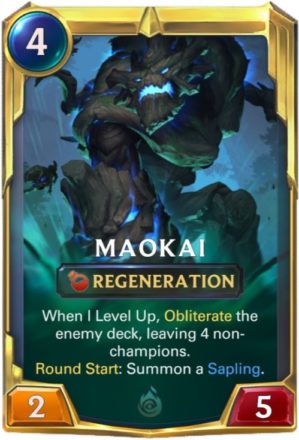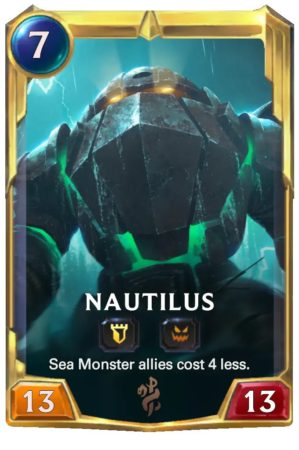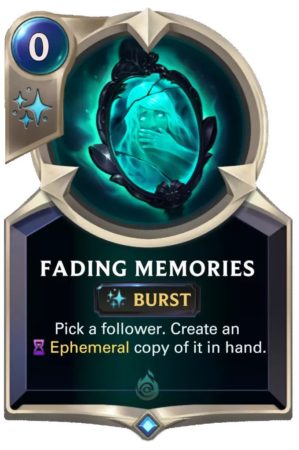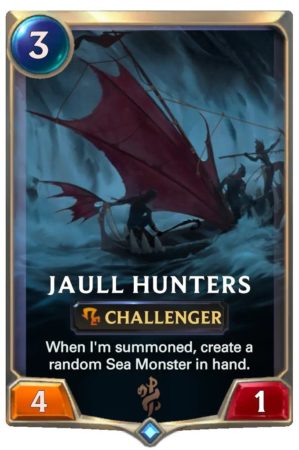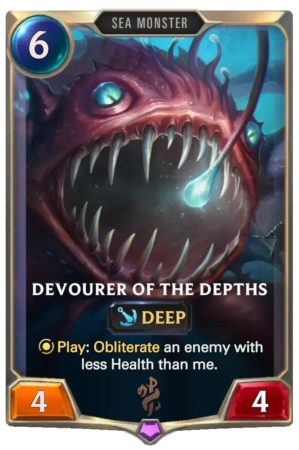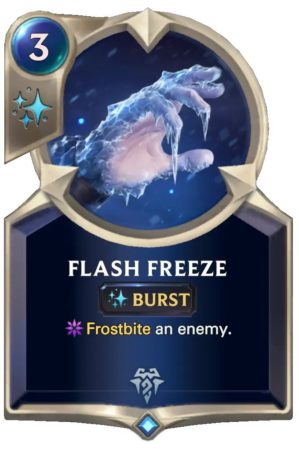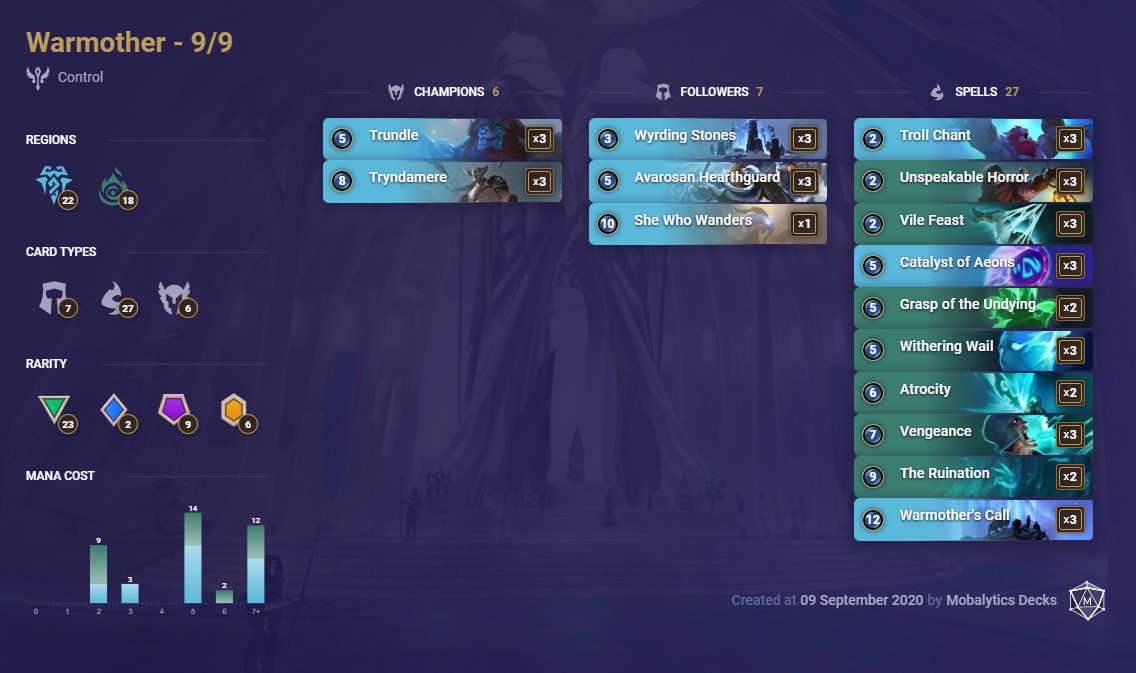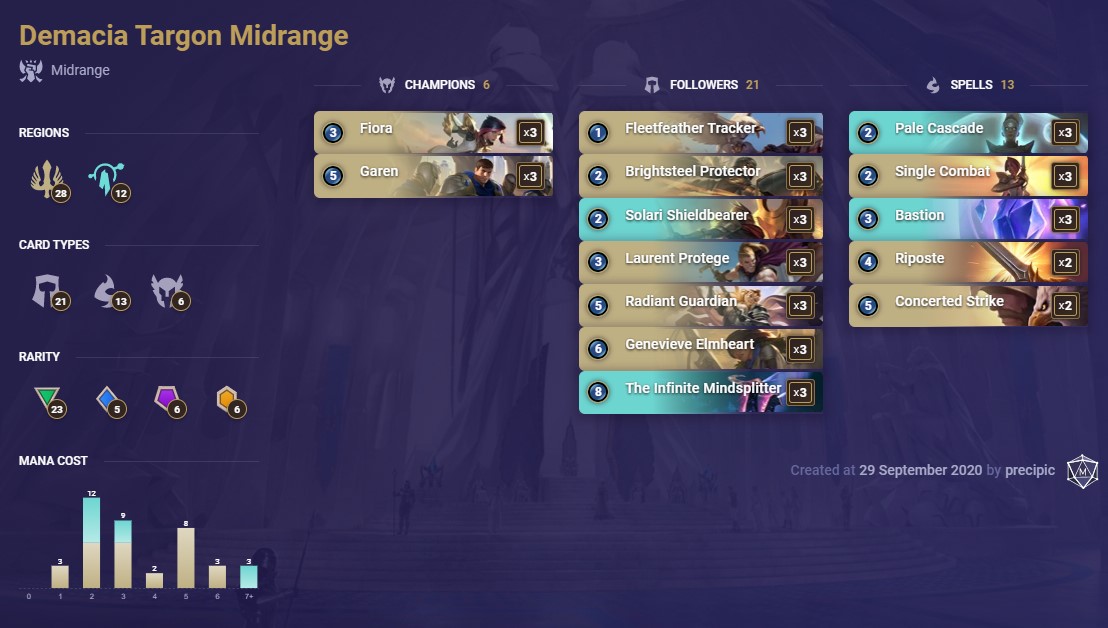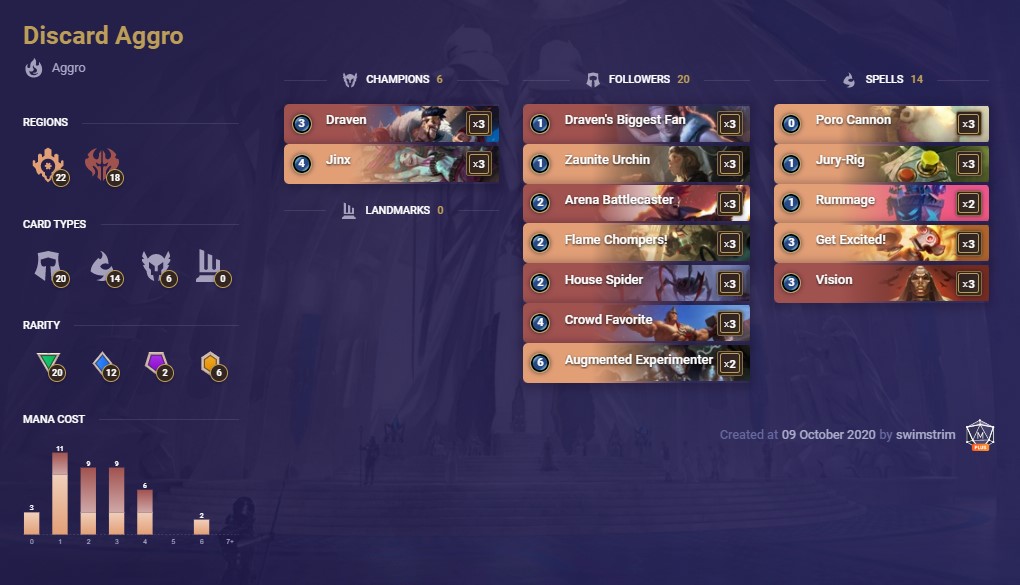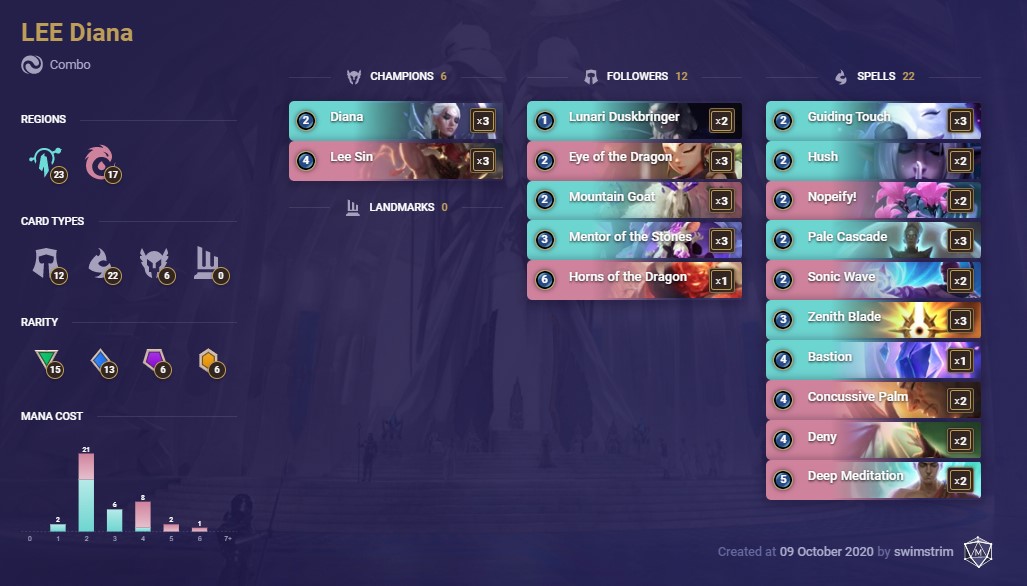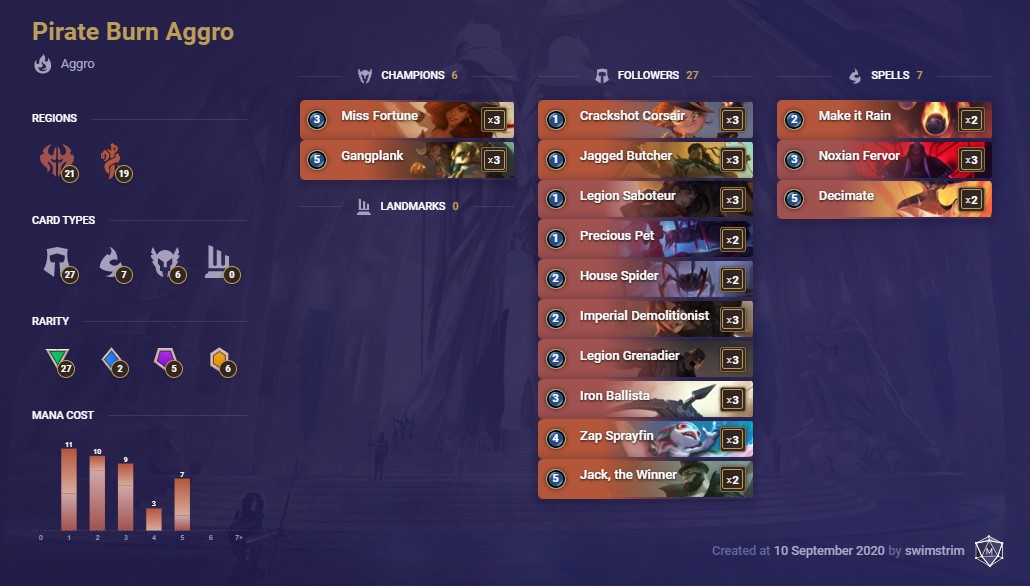How to Play Slaughter Docks Deep (Monuments of Power)
With the addition of Slaughter Docks as a new landmark in Legends of Runeterra, the Deep archetype got an extra tool to utilize. The new landmark is 3 mana and reads, “Round Start: Toss 1. If you are Deep, destroy me to summon a random Sea Monster.”
Deck code: CECAKAQGE4WC6NJYAIAQKHJIAIBAKCAKAEBQMAIDAIAQKGJPAEBAMBIBAICQOAQBAIDCKAIBAUAQ
[See Slaughter Docks Deep deck details]
The landmark is interesting because it ultimately helps Deep decks Toss cards more consistently (albeit slowly). It then turns a 3 mana card into a big unit once we hit Deep.
The smallest Sea Monster in Runeterra is Abyssal Eye which, when Deep, is a 6/6 Elusive unit.
It goes without saying that if we are able to get Deep, we’ll have some big units coming into play for the early game tempo loss to help us stabilize the board and hopefully, allow us to close out the game.
Win Conditions
The deck has two major win conditions. The first one is winning with Maokai.
When Maokai levels, he destroys the opponent’s deck except for 4 non-champion cards. He is one of the few mill strategies that LoR has.
The other common way that this deck wins is through Atrocity. Nautilus becomes a 13/13 giant when leveled.
An Atrocity on Nautilus often sticks for 13 direct damage to the opponent’s Nexus.
When this deck doesn’t win through Maokai or Atrocity, it is often due to out-tempoing the opponent through Sea Monsters that are Deep which allow them to have bonus stats that overtake the board.
The Mulligan Phase
The general mulligan for this deck is finding early Toss cards such as Dreg Dredgers and Deadbloom Wanderer.
Against control opponents, Slaughter Docks can be an okay keep as it can be played early without much punishment for the slower tempo plays.
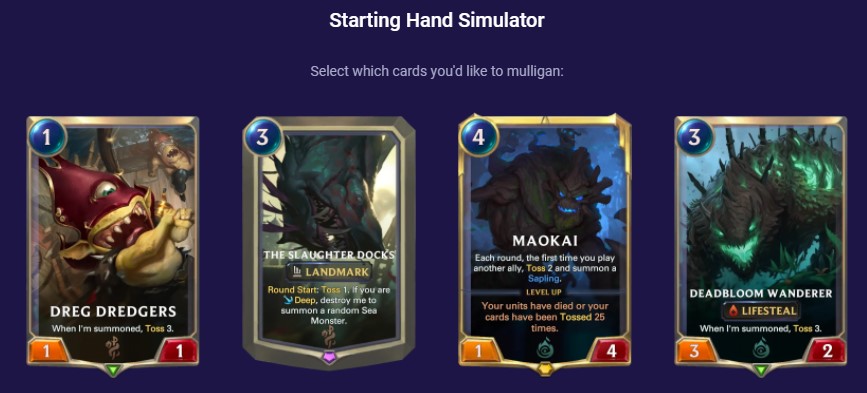
Practice your mulligan phase with the Starting Hand Simulator.
Against those same control decks, keeping Maokai is ideal. Maokai is able to punish ANY and all slow/control decks in the game.
In the mirror, the opponent who can level up Maokai first is generally favored. It is important to keep Maokai in the starting hand and use his Toss 2 and create a Sapling ability to get to his win condition quicker.
Against aggressive lists, it is ideal to keep Withering Wail, Vile Feast, and Deadbloom Wanderer as healing options against decks that rely on doing damage early.
Keeping Hired Gun is also a solid option as it allows for clean trades with 1 drops from Noxus and Bilgewater such as Precious Pet and Jagged Butcher.
Key Synergies
There are several Toss cards in the deck to help get to Deep faster as well as leveling up Maokai. The Toss cards are generally early game cards that help defend against the early game aggression of an opponent.
These Toss cards can often be paired with Maokai on board as well. This is because when a friendly creature is played with Maokai on board, he creates a Sapling and Tosses 2 additional cards.
An additional synergy is Fading Memories. Fading Memories works well with this deck because most cards have the ability to Toss cards.
Fading Memories, which allows us to create an exact Ephemeral copy of any unit, helps us get Deep quicker while contributing to Maokai’s level up condition (Ephemeral units that die count as a proc).
Furthermore, Fading Memories has excellent synergy with Jaull Hunters as well, especially during an attack turn. Playing Fading Memories on Jaull Hunters allows you to force an attack with an Ephemeral unit while generating a random sea monster in our hand.
Last but not least, Fading Memories can be used to copy the opponent’s cards or your own and can gain value from cards with powerful summon or Play effects. It is incredibly flexible and a great addition to Deep Decks.
Slaughter Docks helps the deck get to Deep more consistently through Tossing 1 at the start of each round.
Once it hits Deep, it turns into a Sea Monster which gives you a bit of recovery after playing some of the Toss cards that are a bit “slower” in stats compared to other cards of similar costs.
We can effectively look at this card as a 3 mana, “Summon a Sea Monster unit and Toss 3”, (assuming we play it on 3, under the assumption that we get Deep by turn 6).
Once the deck reaches Deep, the Sea Monsters in the deck begin to take over. These creatures are overstated in the Deep phase of the game.
In this decklist, we are running Abyssal Eye which is an Elusive fish which draws a card per a Nexus Strike.
Devourer of the Depths is one of the main control Tools of the deck. It can Obliterate any creature or champion with less health than its own. You may also have additional Sea Creatures that were created from Jaull Hunters or Slaughter Docks.
Due to Tossing your own cards, it is likely that you will be low on cards in your own deck. This is where Nautilus comes in to make sure that you don’t accidentally mill yourself.
Upon reaching Deep, Nautilus gains his 13/13 stat line and shuffles all Tossed 4+ cost allies back into your deck. On top of this, in his leveled up form, he reduces the cost of all Sea Monsters by 4.
This allows you to play multiple Sea Monsters on one turn with ease. If you have Atrocity in hand and have been able to pressure your opponent earlier in the game, there may be an opening to use Atrocity on Nautilus against your opponent.
However, be careful as Flash Freeze is common in the meta and will counter your Atrocity if you are against Freljord.
There are other cards such as Vengeance and Deny that can stop your lethal as well. Make sure to get your opponent to a low amount of mana or in a dire situation before using Atrocity on Nautilus.
If this wasn’t enough, you also have Maokai waiting for you as well if you have not already played his leveled up form. Because Toss cannot destroy champions, you know you are bound to draw them as the game continues.
This makes finding Maokai and Nautilus easy and consistent with the assumption that you were able to play several Toss cards in the first 5-7 turns. Once 25 units have been Tossed or died, Maokai is ready to obliterate the opponent’s deck!
Good Matchups (and How to Win Them Consistently)
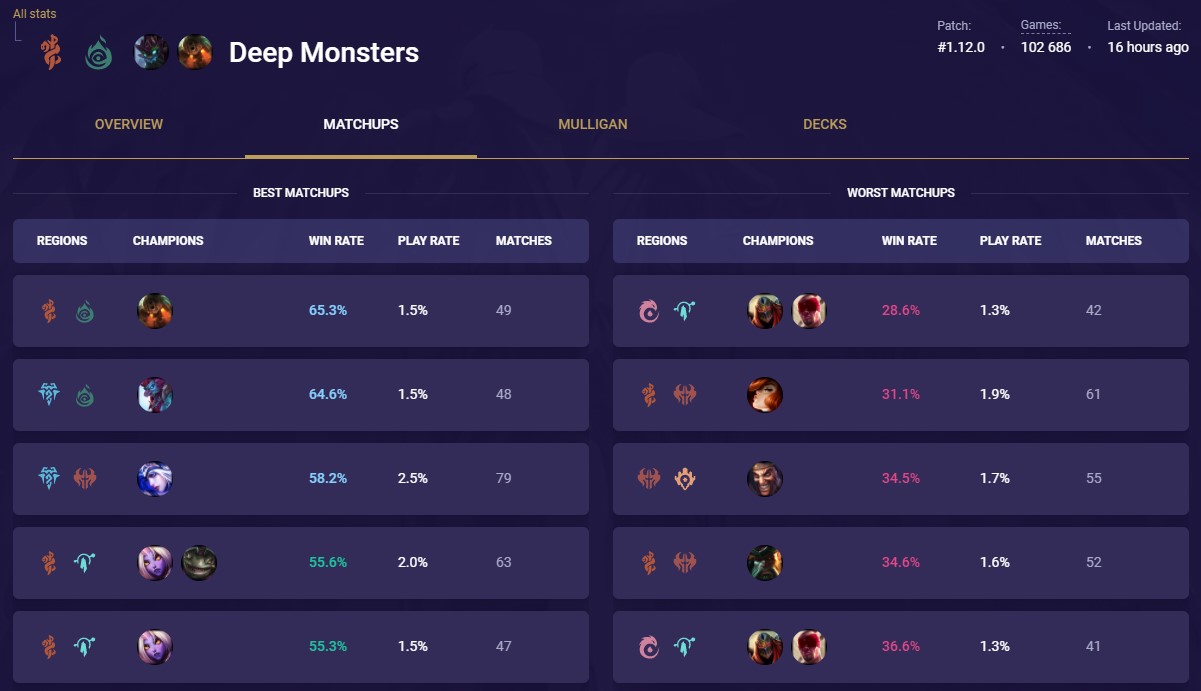
Head to our Meta Stats feature to see more Matchup stats!
Trundle Warmothers
Warmother decks don’t have too many ways of preventing our greedier plays. We’ll actually want to lose tempo in the early game to do exactly that.
Tossing as many cards as possible and leveling Maokai is the easiest win condition. Make sure to not summon Maokai until we’ve leveled him :).
Dragons
It goes without saying that Dragons are in a rough patch. There’s really not much to mention here because they don’t have consistent and effective plays on turns 1 through 3.
This allows us to again play comfortably towards our win cons with greedier mulligans and minus tempo plays to get Deep quicker.
Tahm Raka
Tahm Raka is an interesting one. Long story short, the game will play out in such a way that they simply cannot deal with a board of Deep units and/or Elusive creatures.
Not only that, but they really don’t have outs to Maokai. We’ll win the game so long as we can dodge Starspring.
Discard Aggro
This is an interesting one as well! You would assume that a deck like Discard Aggro which is able to get wide quickly and play with cards like vision is able to simply overwhelm us.
Unfortunately, the Deep deck plays early curve units which allow it to trade well into units with lower stat lines. For example, Toad is actually able to get 2 good trades while healing us for 2.
In addition, cards like Dead Bloom, Withering Wail, and Maokai all get more value in this matchup than almost any other matchup.
Bad Matchups (and How to Give Yourself a Better Chance at Winning)
Lee Sin Targon
Lee Sin is not only one of the best tier 1 decks in the meta. It also happens to be the best deck choice when trying to punish slower decks.
We simply don’t have a way to deal with Lee Sin when it’s backed up by Deny.
MF/GP
Unlike the Discard Aggro deck, MF/GP decks have high statted units. This allows them to stick to the board and deal damage over multiple turns.
Even though we can typically stabilize the board by turn 5 or 6, we’ll have likely lost too much H{ and will get burned out by Decimates and/or Gangplank.
Tech Choices
Grasp of the Undying
- Generally a good card when we see more Discard Aggro and MF/GP decks.
Vengeance
- Good vs slower and/or combo decks relying on their champions to stick on the board.
Shipwreck Hoarder
- This card can be played in more greedy metas but it is not necessary for a win condition in the deck. You can always add this in for a little more RNG fun!
Hired Gun
- This card is excellent in most metas especially when it can make trades against aggressive turn 1 plays. It can also be useful against ramp decks as the Vulnerable on a Wyrding Stone can make it easier to destroy the opponent’s extra mana generators.
Salvage
- If we ever find ourselves to be in slightly slower metas, Salvage will be an auto-lock.
- The card has way too much synergy with our goal of getting Deep quickly. Furthermore, given that we play cards with low value and are usually trading down, replenishing our hand is always important.
Mist’s Call
- The card is GREAT in more aggressive metas where Deadbloom and Maokai need to stick on the board.
Riptide
- Great vs Swain/TF, Endure, and Lee Sin decks. In short, great for tournament play.
Thanks for reading! If you have any questions, feel free to ask Silverfuse during her streams (usually daily from 2-6PM CST).
Catch Silverfuse live at www.twitch.tv/silverfuse
Subscribe to our newsletter:
Don’t miss out on all of the latest LoR content!
 Download APP
Download APP